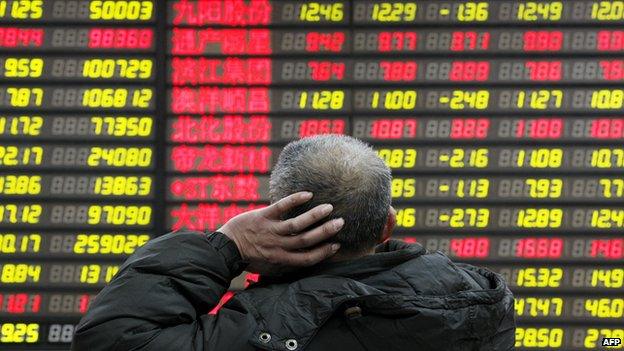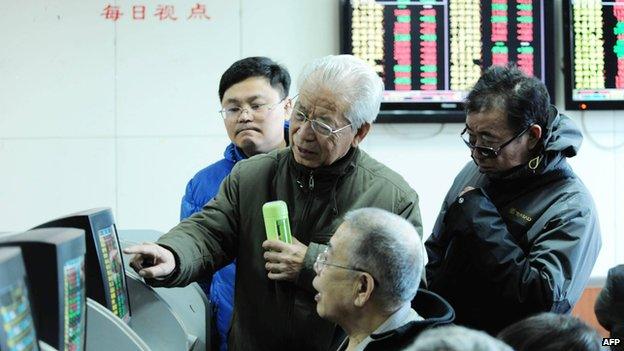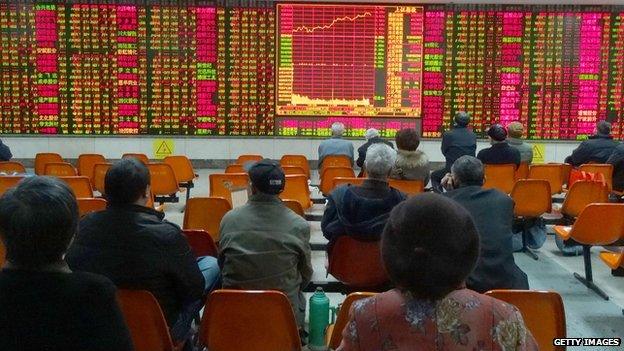Bull run in Chinese shares is just the 'beginning'
- Published

The benchmark Shanghai Composite outperformed every major index in the world to rise over 50% in 2014
China's benchmark Shanghai Composite index was the best performing major stock market in the world last year.
It jumped nearly 53% in 2014, significantly outperforming all major global markets, and breaking through 3,000 points in early December for the first time since 2011.
This may be surprising considering the headlines of the bull run in US equities with New York's S&P 500 hitting records in over 50 trading sessions throughout last year.
But in comparison, the S&P 500 gained about 12% in 2014, while another major US index - the Dow Jones Industrial Average - saw a single-digit yearly gain of 8%.
Even within the region, no other major Asian index came close to the increases seen by mainland Chinese shares last year. Its closest competitor was India's benchmark BSE index, which rose almost 30%.
Analysts say a combination of factors drove the rally in equities - mainly in the last quarter of the year - such as monetary easing by China's central bank, government-led structural reforms and the opening of mainland markets to foreign investors.
Big turnaround
The Shanghai Composite was "languishing" behind other major benchmarks at the beginning of 2014, says Jason Hughes, head of Singapore at trading firm CMC Markets.
"You could even argue that it's really in the last couple of months of the year that we really saw proper momentum build and the sharp rise with 40% of the gains coming in the last two months," he says.
The index rose 37% in the last three months of 2014 - that is more than triple the gains it saw in the first nine months of the year.
Also in those last few months, there were two major catalysts that triggered the rally in Chinese equities.
In November China's central bank unexpectedly cut interest rates for the first time in two years to boost the flagging economy after a series of data pointed to a sharper than expected slowdown.
Growth in the world's second largest economy had slowed to 7.3% in the third quarter from the previous year, which was its lowest level in over five years. Many economists believe that China will miss its 2014 annual growth target of 7.5% for the first time in 15 years.
With expectations that China's growth will continue to ease to around 7% in 2015, authorities will continue to introduce measures to prop up the economy, says Mr Hughes.
"The continuation of supportive monetary policy from the government will tend to mean the market still looks like a very attractive place for people to park their money," he says.

Retail investors play a big part in determining movements in the Shanghai Composite Index
Reform boost
Retail investors, who make up about 80% of China's trading volume, have been moving money out of property and other asset classes and putting it into stocks for the first time in years, say analysts.
Banking stocks have performed particularly well, with share prices in China's four biggest banks up between 36-63% last year.
Helen Zhu, head of Chinese equities at investment firm BlackRock, says this is largely due to "significant" government reforms: "Some of the reforms have made the banks lower risk - shadow banking has seen new regulations."
"Risky" lending is a big problem in China, which was home to the world's third largest "shadow banking" sector in 2013, according to the Financial Stability Board, a taskforce set up by G20 economies.
The sector includes off-balance sheet forms of financing and lending from non-traditional institutions, which are less regulated than formal lenders.
Policymakers have repeatedly vowed to rein in the country's shadow banking activity, which is believed to be worth almost $3tn in assets.
In April, the country's banking regulatory body introduced measures including holding officials personally accountable for irresponsible lending to curb such loans.
"These are the types of structural changes, not just cyclical monetary adjustments, that make people feel more comfortable with these sectors," says Ms Zhu.

Opening the Shanghai exchange to foreign investors is part of the government's plan to liberalise markets
Opening up the market
The second trigger in November happened when foreign investors gained access to the mainland market after the Shanghai-Hong Kong Stock Connect was launched.
The trading scheme allowed foreign investors to trade in the Shanghai market for the first time via the Hong Kong stock exchange, while mainland investors could trade in Hong Kong stocks from Shanghai.
While anticipation was high that the link would give a big boost to the amount of capital flowing into both markets, the move got off to a slow start.
In the first month, only about 22% of the overall $48.4bn (£40bn) that could have flowed into the mainland market from the link had come in, according to exchange figures.
Ms Zhu of BlackRock says the scheme was never really expected to lead to foreigners dominating a large percentage of the money flows in the Shanghai Composite.
"Rather, it shows domestic investors that this is opening the gates to a medium to longer trend and that's for more investor participation in the market overall.
"They recognise that over time a lot of the really cheap, valuation depressed sectors that are large companies on the index will end up seeing more buying interest from this new group of participants."
Just the 'beginning'

Shanghai is set for another year of big gains because of its undervalued position, say analysts
Despite its sharp rise in the past few months, the Shanghai Composite benchmark is still some way off its all-time high of 6,124.04 points, reached in October 2007.
"The market is cheap - the high was in 2007 and then it dropped 70%," says Hans Goetti, head of Asian investment at Banque Internationale a Luxembourg (BIL) in Singapore.
"Since then it's been in a sideways move and now it's started to move up again."
Strategists expect the index to continue rising in 2015 but are split as to whether it will reach those heady heights again.
Mr Goetti expects the index to jump another 39% from the current level to hit 4,500 points in the next 12 to 24 months.
"It will not go up in a straight line. It really had a tremendous move now from 2,000 to 3,300 [points]," he says.
"I'm not expecting it to continue at this pace, probably a pullback in the near term towards 3,000 and then maybe a slower type of uptrend but an uptrend nevertheless."
But BlackRock's Ms Zhu says the bull market in Chinese shares is "very much the beginning of the trend", while Mr Hughes from CMC Markets agrees, adding that in the next 12 months the index could jump another 60 to 70%.
"You've got pretty strong forecasts being suggested with people talking over the next 12 to 24 months that potential to push back up to those 2007 highs," he says.
- Published5 January 2015

- Published21 November 2014

- Published10 November 2014
